Introduction

Backache because of age-related changes may radiate to the legs due to pressure on the spinal nerves. Backache is extremely common affecting 80%-90% of adult men and women between the ages of 30 and 50 years of age. Backache is a particular challenge because it is so common, demanding of medical resources and a major cause of physical, psychological and social disability. The best way to prevent backaches is to care for the back by keeping the back muscles in excellent physical condition. This requires back and abdominal exercises as a daily regiment. Sit-ups, leg raises, flattening the back and tucking the legs to the chest strengthen the muscles. These exercises should be avoided during active back pain, but the stretching exercises can be continued.
Yoga and Anaemia
Yoga is excellent relaxation therapy which provides freedom from stress and strain and helps to attain mental harmony. It increases self awareness so that one can know one's self better so as to provide a perfect treatment on the own whenever desired. Yoga works wonders as it treats the body from within so that it can be rejuvenated from outside. A good, regular yoga practice will go far in relieving the stress and tension that sometimes cause mild back pain, and in fact, studies have shown that yoga is the number one most effective exercise for relieving back pain. The common causes of lower backache are either stiffness in the ligaments or muscles of the lower back, or weak abdominal muscles. Poor posture and lack of exercise usually lead to tight and swollen back muscles, resulting in pain in this area.The inhalation and exhalation exercise of yoga called pranayam (Breath exercise) provides comfort and relaxation to the muscles of the back and the body so that whole body rejuvenates in order to enjoy better health and zeal. Back pain is often the result of a biomechanical imbalance in spinal structures. Yoga for back pain has been accepted by many chiropractors and back specialists. Yoga is a fantastic physical and mental activity. It might not cure every type of pain, but it will increase your general health. A physically and mentally healthy person is always more prepared to deal with back pain than a person in poor health. And this compensation requires the contraction of the muscles in your shoulders and upper back. Keeps you from enjoying many of life's activities, then try yoga for back pain and finally live life as you once did.
YOGA POSES FOR BACKACHE
Side-Angle Pose
The side-angle yoga pose is a good one to help alleviate back pain. Side-angle helps with postural conditions that can cause back pain such as scoliosis and kyphosis. It also stretches the core muscles of the body, including your oblique abdominals.Triangle Pose
Triangle or trikonasana is a yoga pose that may benefit a back pain sufferer in a unique but powerful way. Triangle pose works the hips, and the hips have a strong influence on the spine and on back pain. Learn about trikonasana and back pain.Cat Cow Pose
The Cat-Cow Stretch is a pose that enjoys tremendous popularity in many systems of exercise and movement from yoga to pilates and core strengthening programs. The Cat-Cow Pose does many things, from establishing ideal spinal alignment to strengthening and stretching back muscles and developing coordinated spinal movement.Downward Facing Dog Pose
Yoga can be an excellent form of exercise for back pain, as long as it's done carefully. The downward facing dog pose, also known as "down dog" is a basic but challenging yoga pose that can yield many benefits for the back pain sufferer.Cobra Pose
The basic movement of the cobra pose is to arch the spine backward as you lie on the floor on your stomach. While a great stretch, it poses special concerns for people with back pain.Fish Pose
Fish yoga pose extends your chest, reduces nasal congestion, backache and sinus problems. It stimulates Thyroid and Parathyroid glands as well.Sage Twist Pose
This is also known as ardha matsyendrasana. Start like paschimothanasana. Rest right foot on left knee clamping it there, lock it by your left armpit and support yourself by resting right palm on the floor on the right side. Bend the left knee so much as to touch your hips by left heel. Twist torso as much as is possible to right and breathe 4-5 times. Go back to original position and do it for the next leg.Child Pose
This is one of the effective yoga postures to reduce stress and anxiety. Proceed from shvana asana. With knees spread fully on the floor bend forward so much as to touch your belly to thighs and forehead to ground. Keep the hands fully stretched in front of you.YOGA ASANAS FOR BACKACHE
PRASARITA PADOTTANASANA
This is a good stretching exercise that reduces the stiffness, tiredness and tension in the muscles in your hind legs. At the same time, the muscles of the back and the neck are thoroughly stretched and you learn to deal with possible stretching aches.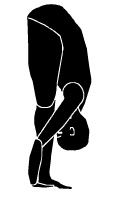
Steps
- Stand in Tadasana. Place your hands on your hips, with your thumbs on your back and your fingers on the front of the hips. Inhale, and spread your feet 1.2m (4ft) apart. Your feet should be parallel to each other, the toes pointing forward. Press the outer edges of your feet to the floor. Keep your back erect.
- Exhale, and lift both kneecaps. Bend forward, extending your spine and bring your torso down toward the floor. Lookup as you bend to ensure that your back is concave. Take both hands off your hips, and lower them to the floor. Place your palms flat on the floor with your fingers spread out.
- Widen your elbows, keeping your palms flat on the floor. Place the crown of your head on the floor, between your palms. Push your sternum forward and draw the abdomen in. Move the thighbones and groin back to reduce the pressure on your head. Stay in the pose for 1 minute.
TADASANA URDHVA HASTASANA
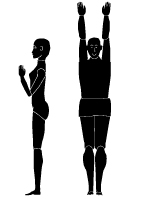
Steps
- Stand in your bare feet in Tadasana on an even. uncovered surface. Exhale, and stretching from your waist, lifts your arms in front of you, to shoulder- level. Keep your palms open and facing each other.
- Raise your arms above your head, perpendicular to the floor.
- Stretch your arms and fingers. Push your shoulder blades into your body.
- Stretch your arms further up from your shoulders, keeping them parallel to each other. Extend your wrists, palms, and fingers toward the ceiling. Feel the stretch along both sides of your body.
- Pull in your lower abdomen. Turn your wrists so that the palms face front. Hold the pose for 20-30 seconds. Breathe evenly.
ARDHAMATSYENDRASANA
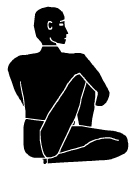
Steps
- Sit on the ground, stretching both the legs forward. Bend your right leg and place the heel under the left hip.
- Now bend your left leg, cross it over and place your foot by the side of the right knee. Try to hold the left ankle by passing the right arm over the left side of the left knee. At the same time, exhale and take the left arm behind the back and press the right side under the ribs.
- This has to be done by twisting the trunk to the back as much as possible. Maintain this posture for a few seconds and increase the duration to two minutes gradually.
- Repeat the same process on the other side for the same duration.
UTTHITA TRIKONASANA
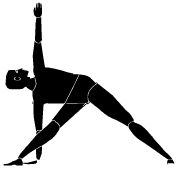
Steps
- Spread a mat against a wall. Place a wooden block on its ling side on the right edge of the mat. Stand in Tadasana on the centre of the mat. Inhale, then spread your feet about 1m (3.5ft) apart. Your heels and buttocks should touch the wall. Raise your arms out to your sides until they are in line with your shoulders.
- Now, turn the right foot out to the right until it is parallel to the wall. Turn your left foot in slightly to the right. Your left heel and buttocks should touch the wall. Keep your left leg straight. Stretch your arms away from your body, keeping them parallel to the floor, with your palms facing down.
- Bend to the right and extend your right arm toward the floor. Place your right palm on the block. Pull the tailbone into your body, keeping your left buttock and shoulders firmly pressed to the wall. Raise the left arm up toward the ceiling. Turn your head and look at your left thumb. Rest you weight on both heels, and not on your right palm. Breathe evenly, not deeply. Hold the pose for 20-30 seconds. Repeat the pose on the other side.
ARDHACHANDRASANA
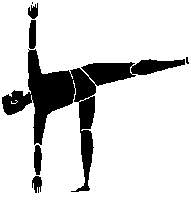
Steps
- Stand in Tadasana. Place a block on its short side against the wall. Inhale, spread your feel 1m (3.5ft) apart. Raise your arms to shoulder-level.
- Turn your right foot out to the right, parallel to the wall, and turn your left foot in, slightly to the right. Bend your right knee, and place the right palm on the block. Raise your left arm.
- Straighten your right leg. Raise your left leg, until it is parallel to the floor. Keep your left arm stretched up, in line with the right arm. The back of your left hand should touch the wall.
- Look up at your left thumb. Keep your weight on the right foot, thigh, and hip, not on your right palm. Hold the pose for 20 seconds. Repeat the pose on the other side.
Diseases Related to Leo |
||


